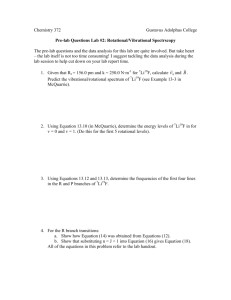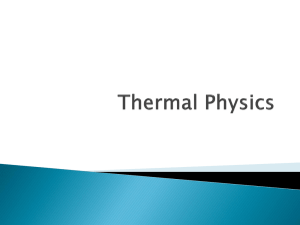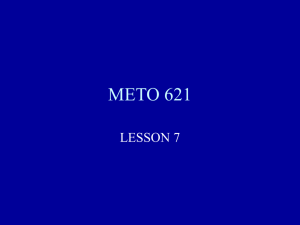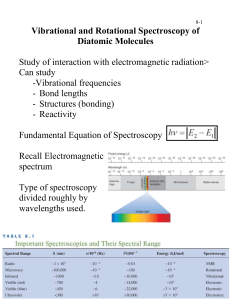Monte Carlo Direct (Test-Particle) Simulation of Rotational
advertisement
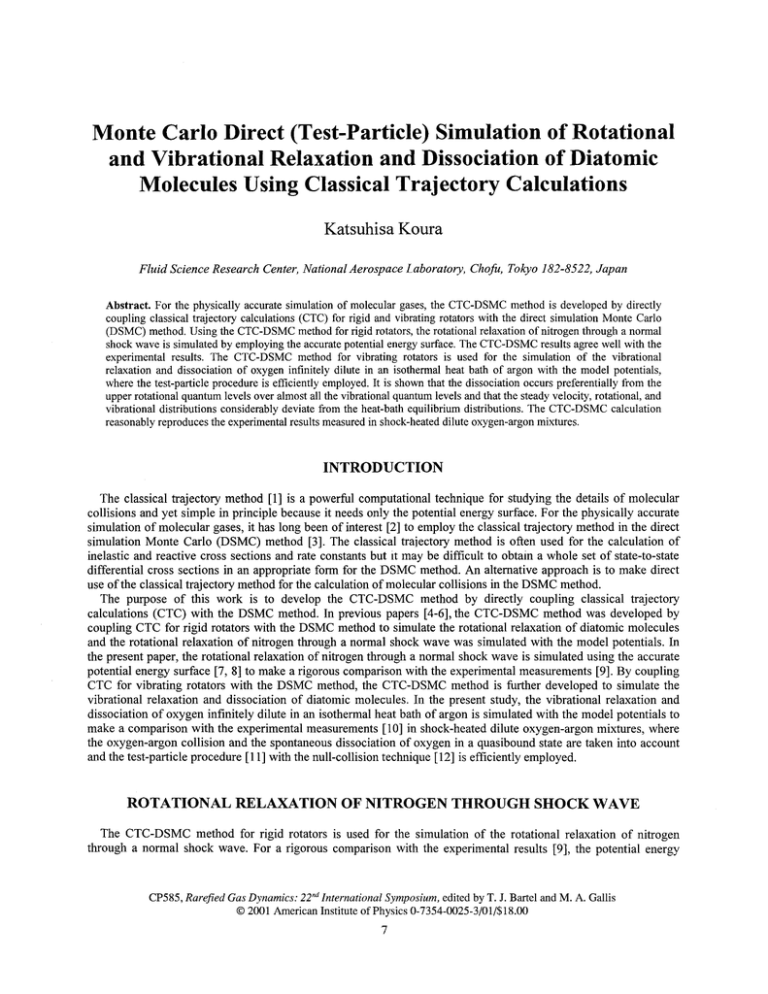
Monte Carlo Direct (Test-Particle) Simulation of Rotational
and Vibrational Relaxation and Dissociation of Diatomic
Molecules Using Classical Trajectory Calculations
Katsuhisa Koura
Fluid Science Research Center, National Aerospace Laboratory, Chofu, Tokyo 182-8522, Japan
Abstract. For the physically accurate simulation of molecular gases, the CTC-DSMC method is developed by directly
coupling classical trajectory calculations (CTC) for rigid and vibrating rotators with the direct simulation Monte Carlo
(DSMC) method. Using the CTC-DSMC method for rigid rotators, the rotational relaxation of nitrogen through a normal
shock wave is simulated by employing the accurate potential energy surface. The CTC-DSMC results agree well with the
experimental results. The CTC-DSMC method for vibrating rotators is used for the simulation of the vibrational
relaxation and dissociation of oxygen infinitely dilute in an isothermal heat bath of argon with the model potentials,
where the test-particle procedure is efficiently employed. It is shown that the dissociation occurs preferentially from the
upper rotational quantum levels over almost all the vibrational quantum levels and that the steady velocity, rotational, and
vibrational distributions considerably deviate from the heat-bath equilibrium distributions. The CTC-DSMC calculation
reasonably reproduces the experimental results measured in shock-heated dilute oxygen-argon mixtures.
INTRODUCTION
The classical trajectory method [1] is a powerful computational technique for studying the details of molecular
collisions and yet simple in principle because it needs only the potential energy surface. For the physically accurate
simulation of molecular gases, it has long been of interest [2] to employ the classical trajectory method in the direct
simulation Monte Carlo (DSMC) method [3]. The classical trajectory method is often used for the calculation of
inelastic and reactive cross sections and rate constants but it may be difficult to obtain a whole set of state-to-state
differential cross sections in an appropriate form for the DSMC method. An alternative approach is to make direct
use of the classical trajectory method for the calculation of molecular collisions in the DSMC method.
The purpose of this work is to develop the CTC-DSMC method by directly coupling classical trajectory
calculations (CTC) with the DSMC method. In previous papers [4-6], the CTC-DSMC method was developed by
coupling CTC for rigid rotators with the DSMC method to simulate the rotational relaxation of diatomic molecules
and the rotational relaxation of nitrogen through a normal shock wave was simulated with the model potentials. In
the present paper, the rotational relaxation of nitrogen through a normal shock wave is simulated using the accurate
potential energy surface [7, 8] to make a rigorous comparison with the experimental measurements [9]. By coupling
CTC for vibrating rotators with the DSMC method, the CTC-DSMC method is further developed to simulate the
vibrational relaxation and dissociation of diatomic molecules. In the present study, the vibrational relaxation and
dissociation of oxygen infinitely dilute in an isothermal heat bath of argon is simulated with the model potentials to
make a comparison with the experimental measurements [10] in shock-heated dilute oxygen-argon mixtures, where
the oxygen-argon collision and the spontaneous dissociation of oxygen in a quasibound state are taken into account
and the test-particle procedure [11] with the null-collision technique [12] is efficiently employed.
ROTATIONAL RELAXATION OF NITROGEN THROUGH SHOCK WAVE
The CTC-DSMC method for rigid rotators is used for the simulation of the rotational relaxation of nitrogen
through a normal shock wave. For a rigorous comparison with the experimental results [9], the potential energy
CP585, Rarefied Gas Dynamics: 22nd International Symposium, edited by T. J. Bartel and M. A. Gallis
© 2001 American Institute of Physics 0-7354-0025-3/01/$18.00
7
surface (PES) is taken to be the PES8 potential [7], which was derived from the improved (ab initio) PES [8] by
readjusting certain potential parameters and verified to be sufficiently accurate by comparing with various
experimental data. The CTC-DSMC method is detailed in a previous paper [4] and a few modifications are
presented here. The maximum impact parameter bmax for the PES8 potential is taken as that derived from the
attractive term of the Lennard-Jones (LJ) potential using the truncation of the scattering deflection angle less than
0.05°, i.e., bmax=max[3aLj, 3aLj(24eLJ/e)1/6] with the collision diameter au=3.681 A and the well depth eLJ /k=91.5 K
for nitrogen [13], where 8 is the relative translational energy and k is Boltzmann's constant. The initial
intermolecular separation RO (>bmax) is taken to be l.lbmax. Because the experimental rotational distribution yj is
presented for the discrete rotational energy EpkOjG+l) of the rotational quantum level j, 0r being the characteristic
rotational temperature taken to be 2.875 K for nitrogen [14], an even quantum number j for nitrogen is calculated as
j=2xINT[(jc+l)/2] from the continuous quantum number jc defined by the continuous rotational energy
Erot=k0,jc(jc+l), where INT truncates a real number to an integer.
The calculation is made for the upstream Mach number Mi=12.9 and temperature ^=9.15 K corresponding to the
experimental conditions. The cell width Ax along the streamwise coordinate x normalized by the upstream free path
Xi^niTCOu2)"1, ni being the upstream number density, is taken as AxA,i=0.1 and the average molecular number per
cell is taken to be about 100. The profiles of normalized number density n*=(n-n1)/(n2-ni), translational temperature
Tfr* =(Ttr-Ti)/(T2-Ti), and rotational temperature Trot* =(Trot-Ti) /(T2- TO are presented in Fig. 1 as compared with
the experimental data of n* and Trot*, where Trot is defined to be the mean rotational energy <Erot>/k, n2 and T2 are
the downstream number density and temperature, respectively, and the position x is normalized by the sonic free
path L=r|(Ts)/pu employed in [9] with the viscosity coefficient T|(TS) at the adiabatic sonic temperature Ts and the
constant mass flux pu. The agreement is good except the rotational temperature profile in the upstream portion of the
shock wave, where the PES8 profile of Trot* gradually rises before the steep rise of the measured data. This
discrepancy may be attributable to some uncertainties at low temperatures in the CTC-DSMC calculation without
quantum effects or in the experimental measurements.
The relaxation of the rotational distribution yj normalized by the degeneracy gj=2j+l relative to that of the ground
level (j=0) is shown in Fig. 2 as compared with the experimental data. It is indicated that yj relaxes to the
downstream Boltzmann distribution via a bimodal form represented approximately by the merging of two
Boltzmann distributions at the upstream and downstream temperatures in good agreement with the experimental data
except in the upstream portion of the shock wave, x/L—10.3 and -8.2. The discrepancy in the upstream portion may
also be caused by some uncertainties at low temperatures.
-20
-15-10-5
0
FIGURE 1. Profiles of normalized number density (n*) and translational (Ttr*) and rotational (Trot*) temperatures for the PES8
potential (—) as compared with the experimental data [9] of n*(o) and Trot*(a).
100
200 300
E/k(K)
400
500
4
0
200
400 600
E/k (K)
800
1000
FIGURE 2. Relaxation of rotational distribution for the PES8 potential (o) as compared with the experimental data [9] (—). The
value in parentheses is the measured position in the unit of turns. BD! and BD2 denote the Boltzmann distributions at the
upstream and downstream temperatures, respectively.
DIRECT SIMULATION (TEST-PARTICLE) MONTE CARLO METHOD COUPLED
WITH CLASSICAL TRAJECTORY CALCULATIONS FOR VIBRATING ROTATORS
The CTC-DSMC method for vibrating rotators is described for the simulation of the vibrational relaxation and
dissociation of diatomic molecules BC infinitely dilute in an isothermal heat bath of atoms A, where atoms A are
assumed to maintain the Maxwell velocity distribution function at the heat-bath temperature T and the molecular
collision between BC and A and the spontaneous dissociation of BC in a quasibound state are taken into account.
Because the molecular collision and the spontaneous dissociation occur simultaneously, the DSMC procedure for
following a number of molecules BC in a time step At is efficiently performed using the test-particle procedure [11]
where each of molecules BC is followed by turns. The test-particle procedure with the null-collision technique [12]
for following a molecule BC through collisions with atoms A during At is as follows:
For the collision between a molecule BC with the velocity u (u=|u|) and an atom A, the maximum value Smax of
ga(g) is obtained as
Smax - max[gcj(g)], g < g max ,
(1)
=
where gmax u+wmax is the maximum value of the relative velocity g for the effective maximum velocity
Wmax^S^kT/niA)172 of heat-bath atoms A with the mass mA and a(g) is the collision cross section given by
^(g) = J*L(2)
The maximum impact parameter bmax is taken to be so large that a collision with the impact parameter b>bmax may be
ignored. The mean collision frequency (including null collisions) vcon of BC with atoms A is given by
V
c*//="Aiax>
(3)
where nA is the number density of atoms A.
For BC in a bound (b) state [BC(b)], a time interval tcon between successive collisions of BC(b) with atoms A is
assigned from the exponential probability density function with the mean collision frequency vcoii as
t con =-^RN^ coin
(4)
where RN is a uniform random number in the range (0,1). The collision between BC(b) and an atom A with the
velocity w chosen randomly from the heat-bath Maxwell velocity distribution function is determined to be real or
null by the respective real or null probability
Preal = S°(g) / ^max >
P null = 1 ~ P real '
(5)
If the collision is real, the following CTC procedure is taken; if the collision is null, no collision occurs.
For BC in a quasibound (qb) state [BC(qb)], a collision time interval tcon is given by Eq. (4) and a lifetime tiife is
assigned from the exponential probability density function with the mean lifetime Tiife of BC(qb) as
.
(6)
If tiife>tcon, the collision procedure is taken in the same way as that for BC(b); otherwise, BC(qb) is spontaneously
dissociated.
The CTC procedure for the BC-A collision is outlined in connection with the DSMC method; the CTC techniques
for atom-diatom collisions are compiled in a handbook [1, 15] (see also a previous paper [4]). In the center-of-mass
Cartesian coordinate system, a set of twelve Hamilton's equations for the relative position vector R of A with
respect to the center of mass of BC and the conjugate momentum P and for the internal position vector r of BC and
the conjugate momentum p is solved using a variable-step eighth-order Runge-Kutta formula [16] for all the position
vectors and conjugate momenta to attain their numerical convergence to a desired accuracy (<10~5) by halving or
doubling the time-step size. The initial values of R and P of A are obtained from the relative velocity g=w-u, the
spatially uniform impact parameter given by b=bmaxRN1/2, and the initial intermolecular separation RO taken to be
l.lbmax. The initial values of r and p of BC are specified by integrating a set of six Hamilton's equations for r and p
of the isolated molecule BC from the vibrational inner or outer turning point for a time uniformly distributed over
the vibrational period [15] with the initially isotropic orientation of the molecular axis r and angular momentum J.
The trajectory calculation is terminated when the interaction between product molecules becomes negligibly small.
The velocity u of BC after collision is calculated from P. The internal angular momentum J=rxp and energy
Eint=p-p/2jLLBc+VBc(r) of BC after collision are calculated from r and p, where JLIBC is the reduced mass of BC and
VBc(r) is the BC potential with r=|r|. Using the values of J=|J| and Eint3, the molecular state of BC after collision is
determined to be the bound (b) state for Eint less than the dissociation energy De, the quasibound state (qb) for Eint
greater than De but less than the peak value (rotational barrier) of the effective potential Veff(r)=VBc(r)+J2/2|uiBcr2 and
r less than the peak location of Veff(r), or otherwise the dissociated state (the loss of molecule BC). For BC(qb), the
mean lifetime Tiife is calculated by the WKB method [17]. The rotational energy Erot is taken to be the minimum
value of Veff(r) and the vibrational energy E^ is given by Eyib^Eint-Erot. If necessary, the rotational quantum number
j is calculated from the continuous quantum number jc defined by J2=(h/27i)2jc(jc+l), h being Planck's constant, and
the vibrational quantum number v is determined from J and Eint by the WKB quantization method [15].
In the present O2-Ar system, the potential energy surface is represented by the pairwise additive potential. The
intramolecular (BC) potential VBc is described by the Morse potential
VBC(r) = De{l-Qxp[-p(r-re)]}2,
1
(7)
1
with the potential parameters De=42047 cm" , re=1.2075 A, and (3=2.6539 A" for oxygen [14]. For the vibrational
relaxation and dissociation at high temperatures (~104K), the intermolecular (A-BC) potential VABC m&y simply be
taken to be the sum of the AB and AC repulsive exponential potentials
V
ABC (RAB >RAC} = C exp(-oK^ ) + c exp(-0/^c ),
=
(8)
=
where RAB ! R+r/2| and RAC ! R-r/2| are the AB and AC distances, respectively, and c and oc are the adjustable
potential parameters. The standard values of c and a for O-Ar are taken to be c0=3.14xl03 eV and ao=4.01 A"1,
respectively, which were determined for the transport properties at high temperatures [18]. Preliminary calculations
with the maximum impact parameter bmax=(3-10)re confirm that b^ax==5re is sufficient for the model potentials.
VIBRATIONAL RELAXATION AND DISSOCIATION OF OXYGEN IN ARGON
Using the CTC-DSMC method for vibrating rotators, the vibrational relaxation and dissociation of oxygen
infinitely dilute in an isothermal heat bath of argon is simulated to make a comparison with the experimental results
[10] measured in shock-heated dilute oxygen-argon mixtures. It is assumed that argon atoms retain the Maxwell
velocity distribution function at the downstream temperature T of the shock wave and oxygen molecules initially
have the Maxwell velocity and Boltzmann rotational and vibrational distribution functions at the upstream
temperature T0 of the shock wave. The calculations are made for the initial room temperature T0=300 K and the high
10
heat-bath temperature T=8000, 10 000, 15 000, and 20 000 K with the argon number density nA=1.28xl017cm"3
corresponding to the experimental conditions. The potential parameters are taken as c=c0 and oc=a0 except where
otherwise noted. The initial molecular number N0 of oxygen is taken to be 3xl04 or 3xl05.
The semilog plot of the molecular number N of oxygen normalized by the initial number N0 versus the time t
normalized by the collision time t0=[nA7cre2(2kT/m)1/2]"1, m being the mass of oxygen, is shown in Fig. 3 at T=8 00020 000 K. The semilog plot indicates a linear portion with the slope of the steady (nonequilibrium) dissociation rate
constant Kd after a lag time during which the dissociation is greatly inhibited, where Kd is defined by the
dissociation rate equation
dlnN/dt = -KdnA.
(9)
The steady slope increases with increasing T. The lag time at which the extrapolation of the linear portion intersects
the horizontal line log(N/N0)=0 is defined to be the dissociation induction time Ti5 which decreases with increasing T.
The semilog plot of N/N0 versus t/t0 obtained by the equilibrium CTC-DSMC method, where oxygen molecules
retaining the Maxwell velocity and Boltzmann rotational and vibrational distribution functions at the heat-bath
temperature T are followed in the same way as the CTC-DSMC method, is also shown in Fig. 4 at T=8 000-20 000
K. The slope is constant, as is expected, and increases with increasing T. It is noted that the constant slope, from
which the equilibrium dissociation rate constant Kdeq is obtained, is larger than the steady slope of Kd(Fig. 3).
An Arrhenius plot of the equilibrium (Kdeq) and nonequilibrium (Kd) dissociation rate constants is presented in Fig.
5 as compared with the experimental data in the temperature range T=8 000-20 000 K. Kd is remarkably smaller than
Kdeq and the temperature dependence of Kd is in reasonable agreement with that of the experimental data. The
magnitude of Kd, however, exceeds the range of scatter of measured data. Considering the pairwise exponential and
Morse potential models, the difference in magnitude should not be taken too seriously; yet the calculation is made
with the smaller potential parameter c=c0/10 (oc= oco) to indicate that Kd for the smaller value of c is closer to the
experimental data as shown in Fig. 5.
The dissociation induction time TI obtained for c=c0 and c0/10 is compared in Fig. 6 with the experimental data in
the temperature range T=8 000-20 000 K. TI increases with decreasing c and the values of TI for c=c0 and c0/10 lie
within the large scatter of measured data.
It is of interest to investigate the rotational and vibrational quantum levels from which the dissociation occurs
preferentially. When a molecule is dissociated, the rotational (j) and vibrational (v) quantum numbers of the
molecule just before the dissociation are calculated and accumulated. It is noted that the rotational quantum number
of oxygen is odd and given by j=2xINT(jc/2)+l, the maximum rotational level jmax(v) for the vibrational level v
decreases with increasing v, and the largest values of jmax(v) and v of oxygen with the Morse potential are 223 (v=0)
FIGURE 3. Semilog plot of molecular number versus time
obtained by the CTC-DSMC method.
FIGURE 4. Semilog plot of molecular number versus time
obtained by the equilibrium CTC-DSMC method.
11
-I -I ____I____I____I____I____I____I____I
-1.0
8
0.5 0.6 0.7 0.8 0.9 1.0 1.1 1.2
12
16
20
Tx10~3(K)
4
10 /T(K)
FIGURE 6. Dissociation induction time for c=c0 (D) and
Co/10 (0) as compared with the experimental data [10] (o).
FIGURE 5. Arrhenius plot of equilibrium dissociation rate
constant for c=c0 (A) and nonequilibrium dissociation rate
constant for c=c0 (n) and c0/10 (0) as compared with the
experimental data [10] (o).
50
10
20
30
40
50
FIGURE 7. Scatter plot of dissociation from vibrational and rotational quantum level (v, j). The solid line indicates the
maximum rotational level jmax (v).
and 52 (j=l), respectively. The scatter plot of the dissociation from the (v, j) level is shown in Fig. 7 at T=10 000
and 20 000 K. It is remarkable that the dissociation is not limited to high vibrational levels but occurs preferentially
from the upper rotational levels over almost all the vibrational levels.
12
The relaxation of the vibrational distribution yv=Nv/N relative to that of the ground level (v=0) is shown in Fig. 8
at T=10 000 and 20 000 K, where Nv is the molecular number of the vibrational quantum level v obtained by
summing the number of molecules in the (v, j) level over the rotational level j. yv attains the steady nonequilibrium
distribution at t/t0>30 and 10 for T= 10 000 and 20 000 K, respectively, owing to a balance between the rotational
and vibrational excitation and the dissociation. It is indicated that the degree of deviation of the steady distribution
from the equilibrium (Boltzmann) distribution yv(T) at the heat-bath temperature T increases with increasing T,
where yv(T) is obtained in the same way as yv from the number of molecules in the (v, j) level calculated from the
continuous rotational and vibrational energies which are randomly chosen from the Boltzmann distributions at the
temperature T for the bound and quasibound states.
The relaxation of the rotational distribution yj=Nj/N normalized by the degeneracy gj=2j+l relative to that of the
ground level Q=l) is shown in Fig. 9 at T=10 000 and 20 000 K, where Nj is the molecular number of the rotational
quantum level j obtained by summing the number of molecules in the (v, j) level over the vibrational level v. yj
attains the steady nonequilibrium distribution at t/t0>30 and 10 for T= 10 000 and 20 000 K, respectively. The degree
of deviation of the steady distribution from the equilibrium (Boltzmann) distribution y/T) at the heat-bath
temperature T increases with increasing T, where yj(T) is obtained in the same way as yj from the number of
molecules in the (v, j) level calculated from the continuous rotational and vibrational energies which are randomly
chosen from the Boltzmann distributions at the temperature T for the bound and quasibound states. It is noted that at
T=10 000 K the steady population slightly exceeds the heat-bath equilibrium population at j<150 but at T=20 000 K
the overpopulation over the heat-bath equilibrium population disappears.
Figure 10 presents the steady velocity distribution function f(u/u0) at t/t0>10 for T=10 000 and 20 000 K, where
u0==(2kT/m)1/2 is the most probable speed at the heat-bath temperature T. It is indicated that the steady distribution
function deviates slightly and appreciably at T=10 000 and 20 000 K, respectively, from the Maxwell distribution
function at the heat-bath temperature T.
The nonequilibrium steady state appears rather complicatedly for the translational temperature (T^) and the mean
rotational (<Erot>) and vibrational (<Evib>) energies, as is shown in Fig. 11 at T=10 000 and 20 000 K for the
relaxation of the normalized quantities of T/T, <Erot>/kT, and <Evib>/kT together with the equilibrium mean
rotational (<Erot>eq) and vibrational (<Evib>eq) energies at the heat-bath temperature T, which are obtained by
averaging the rotational and vibrational energies chosen randomly from the Boltzmann distributions at the
temperature T for the bound and quasibound states. At T=10 OOOK the steady values of T^. and <Evib> are slightly
and appreciably less than T and <Evib>eq, respectively, but the steady value of <Erot> somewhat exceeds <Erot>eq
owing to the overpopulation at j<150 over the heat-bath equilibrium population (Fig. 9), while at T=20 000 K the
steady values of T^, <Erot>, and <Evib> are considerably less than their equilibrium values owing to the large
T=20000 K
T=10000K
-1
-1
12
D)
O
D)
O
-3
-3
BD
-4,
0
BD
10
20
30
40
-4,
0
50
10
20
30
40
50
v
v
FIGURE 8. Relaxation of vibrational distribution. BDi and BD2 denote the Boltzmann distributions at the initial (T0) and heatbath (T) temperatures, respectively.
13
0
10000
20000
30000
40000
10000
20000
30000
40000
FIGURE 9. Relaxation of rotational distribution. BD! and BD2 denote the Boltzmann distributions at the initial (T0) and heatbath (T) temperatures, respectively.
1.0
1.0
T=20000 K
T=10000 K
0.8
0.8
o
0.6
o
3
0.6
0.4
0.4
MD(T)
0.2
0.0
0.2
0.5
1.0
1.5
2.0
2.5
3.0
0.0
0.5
1.0
1.5
2.0
2.5
3.0
U/U0
U/U0
FIGURE 10. Steady velocity distribution function. MD(T) denotes the Maxwell velocity distribution function at the heat-bath
temperature T.
nonequilibrium in the steady velocity distribution function and rotational and vibrational distributions (Figs. 8-10).
The semilog plot of the normalized mean vibrational energy <Evib>*=(<EVib>eq-<Evib>)/(<Evib>eq-<Evib>o) versus
the time t/t0 is shown in Fig. 12 at T=8 000-20 000 K, where <Evib>o is the initial mean vibrational energy calculated
hi the same way as <Evib>eq. The semilog plot indicates a linear portion with the slope of the steady (inverse)
vibrational relaxation time i^b before the dissociation appreciably influences the vibrational relaxation, where Tvib is
defined by the vibrational relaxation equation
14
<Ernt>/kT
__VT
<Evib>/kT
T=10000K
0
20
40
60
80
100
t/t0
FIGURE 11. Relaxation of translational temperature (TVT) and mean rotational (<Erot>/kT) and vibrational (<Evib>/kT)
energies. The equilibrium values are presented for the mean rotational (- - -) and vibrational (- -) energies.
0.0
-6.0
-0.1
-0.2
^-6.5
•P
-0.3
E
«
"Z-7.0
-0.4
D)
o>>
o
O
-7.5
-0.5
-0.6
'0
8
12
16
-8.0
0.03
20
t/t0
FIGURE 12. Semilog plot of normalized mean vibrational
energy versus time.
0.04 0.05 0.06
T(K)-1/3
FIGURE 13. Landau-Teller plot of steady vibrational
relaxation time for C=CO(D) and Co/10 (0) as compared with
the Millikan-White empirical formula [19] (—).
vib
vib'
^
)
A Landau-Teller plot of the steady vibrational relaxation time pTvib obtained for c=c0 and c0/10 is presented in Fig.
13 as compared with the Millikan-White (MW) empirical formula [19] in the temperature range T=8 000-20 000 K,
where p=nAkT is the heat-path pressure. The magnitude of pi^ at T=8 000 K is closer to the MW formula for the
15
smaller value of c=c0/10 than for c=c0. As T increases, pTvib decreases much slower than the MW formula, which
may not necessarily be valid at T>8 000 K [11, 19].
CONCLUDING REMARKS
By directly coupling CTC for rigid and vibrating rotators with the DSMC method, the CTC-DSMC method is
developed and used to simulate the rotational relaxation of nitrogen through a normal shock wave and the vibrational
relaxation and dissociation of oxygen infinitely dilute in an isothermal heat bath of argon. The rotational relaxation
of nitrogen is simulated using the accurate potential energy surface and the agreement with the experimental results
is good. The simulation of the vibrational relaxation and dissociation of oxygen with the model potentials reasonably
reproduces the experimental results measured in shock-heated dilute oxygen-argon mixtures. It is remarkable that
the dissociation occurs preferentially from the upper rotational quantum levels over almost all the vibrational
quantum levels and that the steady velocity, rotational, and vibrational distributions considerably deviate from the
heat-bath equilibrium distributions.
Although the CTC-DSMC method requires a large amount of computation time and the current use of the CTCDSMC method may be restricted to rather simple simulations of molecular gases, CTC-DSMC results may serve as
informative databases for the construction and assessment of DSMC molecular models. It should be remarked that
the CTC-DSMC method needs simply the potential energy surface and may possibly become a powerful
computational technique for the physically accurate simulation of molecular gases in the near future when the
computer speed and the knowledge of the potential energy surface would greatly be increased.
ACKNOWLEDGMENT
The author would like to thank Shinichi Kojima (Information and Science Techno-System) for useful discussions
and his help in making the computer programs for classical trajectory calculations.
REFERENCES
1.
2.
3.
Bernstein, R. B., Atom-Molecule Collision Theory, Plenum, New York, 1979.
Macpherson, A. K., J. Fluid Mech. 49, 337-351 (1971).
Bird, G. A., Molecular Gas Dynamics and the Direct Simulation of Gas Flows, Clarendon, Oxford, 1994.
4.
5.
Koura, K., Phys. Fluids 9, 3543-3549 (1997).
Koura, K., Phys. Fluids 10, 2689-2691 (1998).
6.
Koura, K., "Direct Simulation Monte Carlo Method Coupled with Classical Trajectory Calculations for Rigid Diatomic
Molecules: Application to Nitrogen Shock Wave," in Rarefied Gas Dynamics, edited by R. Brun et al., CEPADUES7.
8.
EDITIONS, Toulouse, 1999, Vol. 2, pp. 23-30.
Cappelletti, D., Vecchiocattivi, F., Pirani, F., Heck, E. L., and Dickinson, A. S., Mol Phys. 93, 485-499 (1998).
van der Avoird, A., Wormer, P. E. S., and Jansen, A. P. J., J. Chem. Phys. 84, 1629-1635 (1986).
9.
Robben, F., and Talbot, L., Phys. Fluids 9, 653-662 (1966).
10. Wray, K. L., J. Chem. Phys. 37, 1254-1263 (1962).
11. Koura, K., Phys. Fluids 6, 3473-3486 (1994).
12. Koura, K., Phys. Fluids 29, 3509-3511 (1986).
13. Hirschfelder, J. O., Curtiss, C. F., and Bird, R. B., Molecular Theory of Gases and Liquids, Wiley, New York, 1954.
14. Huber, K. P., and Herzberg, G., Molecular Spectra and Molecular Structure. IV. Constants of Diatomic Molecules, Van
Nostrand Reinhold, New York, 1979.
15. Truhlar, D. G., and Muckerman, J. T., "Reactive Scattering Cross Sections III: Quasiclassical and Semiclassical Methods,"
in Atom-Molecule Collision Theory, edited by R. B. Bernstein, Plenum, New York, 1979, pp. 505-566.
16. Prince, P. J., and Dormand, J. R., /. Comput. Appl. Math. 1, 67-75 (1981).
17. Stogryn, D. E., and Hirschfelder, J. O., J. Chem. Phys. 31, 1531-1545 (1959).
18. Cubley, S. J., and Mason, E. A., Phys. Fluids 18, 1109-1111 (1975).
19. Millikan, R. C., and White, D. R., J. Chem. Phys. 39, 3209-3213 (1963).
16
